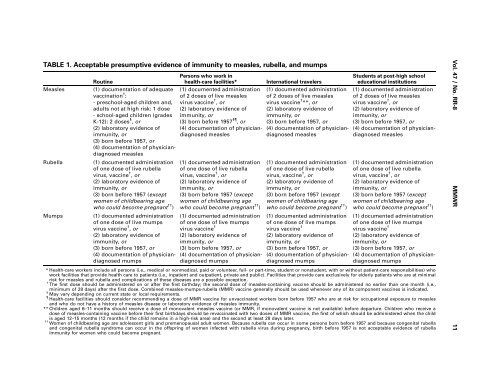Measles, Mumps, and Rubella - Centers for Disease Control and ...
Measles, Mumps, and Rubella - Centers for Disease Control and ...
Measles, Mumps, and Rubella - Centers for Disease Control and ...
Create successful ePaper yourself
Turn your PDF publications into a flip-book with our unique Google optimized e-Paper software.
TABLE 1. Acceptable presumptive evidence of immunity to measles, rubella, <strong>and</strong> mumps<strong>Measles</strong><strong>Rubella</strong><strong>Mumps</strong>Routine(1) documentation of adequatevaccination † :- preschool-aged children <strong>and</strong>,adults not at high risk: 1 dose- school-aged children (gradesK-12): 2 doses § , or(2) laboratory evidence ofimmunity, or(3) born be<strong>for</strong>e 1957, or(4) documentation of physici<strong>and</strong>iagnosedmeasles(1) documented administrationof one dose of live rubellavirus, vaccine † , or(2) laboratory evidence ofimmunity, or(3) born be<strong>for</strong>e 1957 (exceptwomen of childbearing agewho could become pregnant †† )(1) documented administrationof one dose of live mumpsvirus vaccine † , or(2) laboratory evidence ofimmunity, or(3) born be<strong>for</strong>e 1957, or(4) documentation of physici<strong>and</strong>iagnosedmumpsPersons who work inhealth-care facilities*(1) documented administrationof 2 doses of live measlesvirus vaccine † , or(2) laboratory evidence ofimmunity, or(3) born be<strong>for</strong>e 1957 § , or(4) documentation of physici<strong>and</strong>iagnosedmeasles(1) documented administrationof one dose of live rubellavirus, vaccine † , or(2) laboratory evidence ofimmunity, or(3) born be<strong>for</strong>e 1957 (exceptwomen of childbearing agewho could become pregnant †† )(1) documented administrationof one dose of live mumpsvirus vaccine †(2) laboratory evidence ofimmunity, or(3) born be<strong>for</strong>e 1957, or(4) documentation of physici<strong>and</strong>iagnosedmumpsInternational travelers(1) documented administrationof 2 doses of live measlesvirus vaccine † **, or(2) laboratory evidence ofimmunity, or(3) born be<strong>for</strong>e 1957, or(4) documentation of physici<strong>and</strong>iagnosedmeasles(1) documented administrationof one dose of live rubellavirus, vaccine † , or(2) laboratory evidence ofimmunity, or(3) born be<strong>for</strong>e 1957 (exceptwomen of childbearing agewho could become pregnant †† )(1) documented administrationof one dose of live mumpsvirus vaccine †(2) laboratory evidence ofimmunity, or(3) born be<strong>for</strong>e 1957, or(4) documentation of physici<strong>and</strong>iagnosedmumpsStudents at post-high schooleducational institutions(1) documented administrationof 2 doses of live measlesvirus vaccine † , or(2) laboratory evidence ofimmunity, or(3) born be<strong>for</strong>e 1957, or(4) documentation of physici<strong>and</strong>iagnosedmeasles(1) documented administrationof one dose of live rubellavirus, vaccine † , or(2) laboratory evidence ofimmunity, or(3) born be<strong>for</strong>e 1957 (exceptwomen of childbearing agewho could become pregnant †† )(1) documented administrationof one dose of live mumpsvirus vaccine †(2) laboratory evidence ofimmunity, or(3) born be<strong>for</strong>e 1957, or(4) documentation of physici<strong>and</strong>iagnosedmumps* Health-care workers include all persons (i.e., medical or nonmedical, paid or volunteer, full- or part-time, student or nonstudent, with or without patient-care responsibilities) whowork facilities that provide health care to patients (i.e., inpatient <strong>and</strong> outpatient, private <strong>and</strong> public). Facilities that provide care exclusively <strong>for</strong> elderly patients who are at minimalrisk <strong>for</strong> measles <strong>and</strong> rubella <strong>and</strong> complications of these diseases are a possible exception.† The first dose should be administered on or after the first birthday; the second dose of measles-containing vaccine should be administered no earlier than one month (i.e.,minimum of 28 days) after the first dose. Combined measles-mumps-rubella (MMR) vaccine generally should be used whenever any of its component vaccines is indicated.§ May vary depending on current state or local requirements. Health-care facilities should consider recommending a dose of MMR vaccine <strong>for</strong> unvaccinated workers born be<strong>for</strong>e 1957 who are at risk <strong>for</strong> occupational exposure to measles<strong>and</strong> who do not have a history of measles disease or laboratory evidence of measles immunity.** Children aged 6–11 months should receive a dose of monovalent measles vaccine (or MMR, if monovalent vaccine is not available) be<strong>for</strong>e departure. Children who receive adose of measles-containing vaccine be<strong>for</strong>e their first birthdays should be revaccinated with two doses of MMR vaccine, the first of which should be administered when the childis aged 12–15 months (12 months if the child remains in a high-risk area) <strong>and</strong> the second at least 28 days later.†† Women of childbearing age are adolescent girls <strong>and</strong> premenopausal adult women. Because rubella can occur in some persons born be<strong>for</strong>e 1957 <strong>and</strong> because congenital rubella<strong>and</strong> congenital rubella syndrome can occur in the offspring of women infected with rubella virus during pregnancy, birth be<strong>for</strong>e 1957 is not acceptable evidence of rubellaimmunity <strong>for</strong> women who could become pregnant.Vol. 47 / No. RR-8 MMWR 11
















